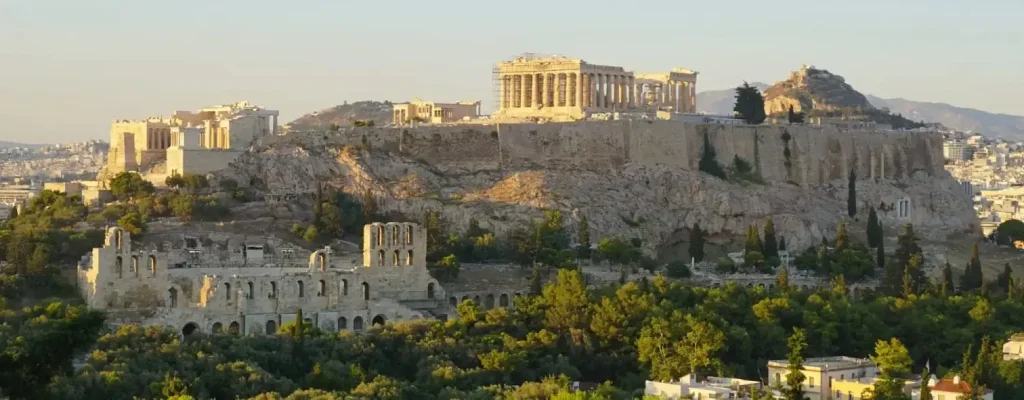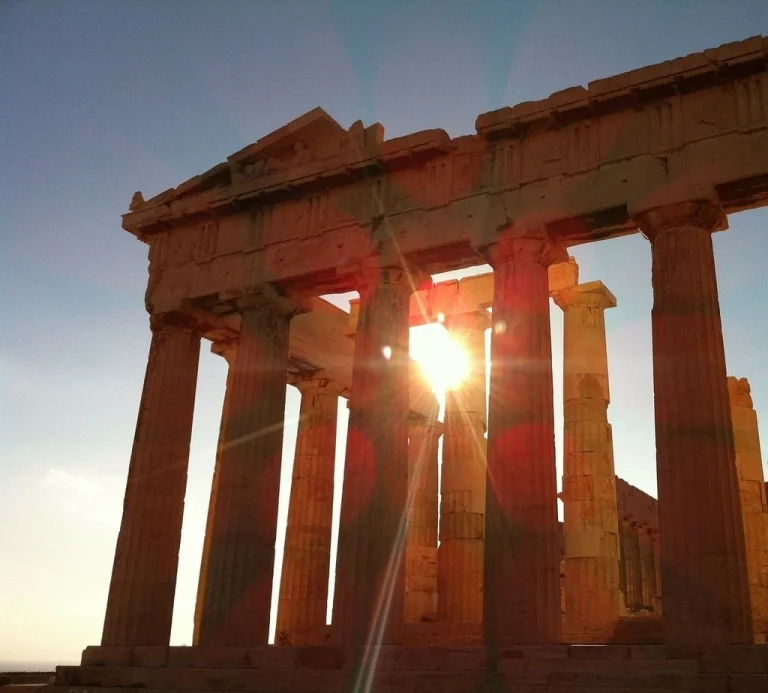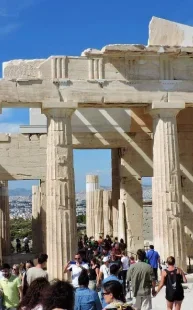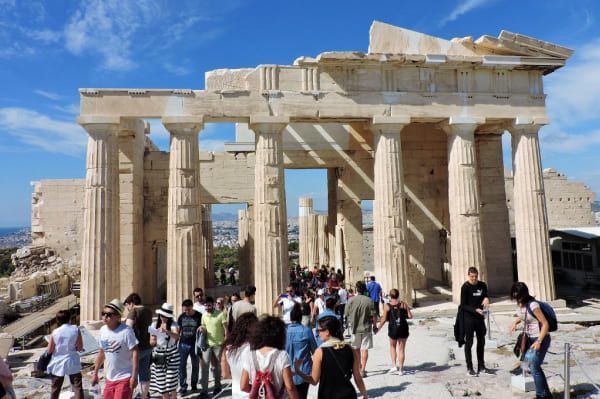Find out when is the best time to visit the Acropolis, both to avoid queues and to protect yourself from the heat of Athens.

The 8:00 AM opening time has become the gold standard for visiting the Acropolis, offering temperatures that are 5-10°C cooler than midday and minimal crowds before the massive cruise ship influx.
This timing is crucial because cruise ships represent a significant challenge – approximately 1.5 million cruise tourists visited Athens in 2023 (a 40% increase), with the Piraeus port handling up to 11 ships simultaneously. These cruise passengers typically arrive at the Acropolis between 9-10 AM, accounting for roughly 50% of daily visitors and creating critical bottlenecks during late morning hours.
The early morning advantage extends beyond avoiding crowds – you’ll experience the site in its most pristine state, with soft morning light illuminating the white Pentelic marble and a contemplative atmosphere that’s impossible to find later in the day.
In addition, the mandatory time slot system implemented in April 2024 means morning slots (9-11 AM) sell out first during high season, making the 8:00 AM entry not just the best experience but often the most available option.
The last two hours before closing offer a premium experience with 70% fewer crowds as tour groups and families head to dinner. The warm evening light creates dramatic illumination on the ancient marble, perfect for photography and romantic occasions.
During summer, arriving at 6:00 PM for an 8:00 PM closure allows you to capture the golden hour magic while enjoying significantly more space to explore and contemplate.

Important update: The Acropolis archaeological site no longer participates in full moon events for security reasons. However, the Acropolis Museum maintains extended hours until midnight during full moon nights (such as August 9, 2025), offering continuous access from 9:00 AM with last entry at 11:30 PM at regular summer rates (€10).
For authentic full moon experiences with Acropolis views, consider alternative locations like Pnyx Hill, Thisio, or rooftop venues throughout the city.
April-May and September–October represent the sweet spot for Acropolis visits, combining comfortable temperatures with manageable crowd levels.
Spring offers 19-24°C temperatures with 13-14 hours of daylight and minimal rainfall (6-8 days per month), while autumn provides similar benefits with September at 26°C (more manageable than peak summer) and October’s perfect 20°C. Both seasons see significantly reduced crowds compared to the overwhelming summer influx of over 16,000 daily visitors.
On the other hand, summer presents serious challenges beyond typical tourist congestion. Regular maximum temperatures of 32-33°C frequently reach 35-40°C, with heat waves pushing temperatures above 42°C. The Greek Ministry of Culture has implemented automatic closure protocols – the site closes from 1:00-5:00 PM when temperatures exceed 40°C, a measure that was triggered multiple times during 2024-2025’s record-breaking heat.
IMPORTANT: the Acropolis experiences a specific microclimate intensification due to Athens’ urban heat island effect (up to 3.5°C during heat waves) and its exposed hilltop location at 107 meters elevation with minimal shade. The ancient marble and stone surfaces absorb and radiate intense heat, meaning site conditions can feel 2-5°C hotter than official Athens temperature readings. It is especially important that you avoid midday hours in summer and stay well informed about the weather and extreme conditions.


If you are going to book a ticket for the Acropolis, you should know that since April 2024, the Acropolis operates under a strict time slot reservation system with a maximum capacity of 20,000 daily visitors. You must book in advance, selecting your specific entry time up to 3 months ahead. Special free entry days include March 6 (Melina Mercouri Day), April 18 (International Monuments Day), May 18 (International Museums Day), the last weekend of September, October 28, and the first Sunday of each month from November to March.
Strategic timing is your most powerful tool against the Acropolis crowds. As we have already mentioned, the 9-11 AM window sees the heaviest congestion due to cruise ship arrivals – with up to 11 ships docking simultaneously at Piraeus port, approximately 2,000-4,000 cruise passengers flood the site during late morning hours. This cruise impact represents roughly 50% of daily visitors and creates the most challenging bottlenecks.
Tuesday and Thursday are consistently the best days for smaller crowds, while weekends (Saturday and Sunday) see maximum congestion from both tourists and locals. Consider using the southeast lateral entrance, which is significantly less congested than the main western entrance. The key is mandatory advance booking through the official platform – morning slots sell out first during high season, making early reservation essential for securing optimal time slots.
Planning your visit duration depends entirely on your interests and available time. A quick 1-1.5 hour visit covers the main monuments from the exterior – ideal for cruise passengers or those with limited time.
The standard 2-3 hour experience allows thorough exploration of all major structures plus the slopes, perfect for combining with the Acropolis Museum on the same day.
History enthusiasts should plan for 4+ hours total, dividing time between the archaeological site and an extensive museum visit.
For the most enthusiastic, the official Acropolis Museum digital guide (Smartify) is completely free and transforms your experience through QR code scanning and audio tours covering either 30 or 60 exhibitions. The app offers native Greek and English content with automatic translation to 29 languages, plus a special 90-minute family exploration game format that makes the visit engaging for children. Additional digital resources include the Acropolis Museum Kids website with interactive games and videos, 3D virtual tours on the official website, and free WiFi throughout the entire museum complex.
If you’re looking for the best way to see the Acropolis, you can take advantage of your visit to take a tour of different points of interest: the Ancient Agora requires 2-3 hours and features the best-preserved classical temple (Temple of Hephaestus), located just 10 minutes walking from the Acropolis. The Roman Agora needs 1-2 hours for the Tower of the Winds and Gate of Athena Archegetis, while the Temple of Olympian Zeus (15 surviving columns from a project that took 700 years to complete) can be covered in 1-2 hours.
Critical update: The official €30 combined five-day ticket was discontinued in April 2024 – you now need individual tickets for each site.
The Acropolis of Athens is Greece’s most popular tourist destination. The Parthenon, the Erechtheion, and the Propylaia are just a few of the…
The Acropolis has played a significant role in Greek history and culture and is widely regarded as one of the most important archaeological…
Taking the metro is a quick and convenient option for getting to the Acropolis in Athens. There are two metro stations that can be used to re…
